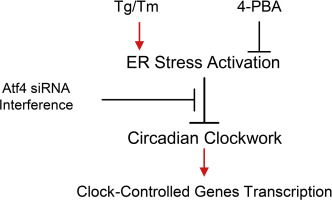当前位置:
X-MOL 学术
›
Cell. Signal.
›
论文详情
Our official English website, www.x-mol.net, welcomes your
feedback! (Note: you will need to create a separate account there.)
ER stress activation impairs the expression of circadian clock and clock-controlled genes in NIH3T3 cells via an ATF4-dependent mechanism.
Cellular Signalling ( IF 4.4 ) Pub Date : 2019-01-28 , DOI: 10.1016/j.cellsig.2019.01.008 Lei Gao 1 , Huatao Chen 1 , Cuimei Li 1 , Yaoyao Xiao 1 , Dan Yang 1 , Manhui Zhang 1 , Dong Zhou 1 , Wei Liu 1 , Aihua Wang 2 , Yaping Jin 1
Cellular Signalling ( IF 4.4 ) Pub Date : 2019-01-28 , DOI: 10.1016/j.cellsig.2019.01.008 Lei Gao 1 , Huatao Chen 1 , Cuimei Li 1 , Yaoyao Xiao 1 , Dan Yang 1 , Manhui Zhang 1 , Dong Zhou 1 , Wei Liu 1 , Aihua Wang 2 , Yaping Jin 1
Affiliation

|
Endoplasmic reticulum (ER) stress and circadian clockwork signaling pathways mutually regulate various cellular functions, but the details regarding the cross-talk between these pathways in mammalian cells are unclear. In this study, whether perturbation of ER stress signaling affects the cellular circadian clockwork and transcription of clock-controlled genes was investigated in NIH3T3 mouse fibroblasts. An NIH3T3 cell model stably expressing luciferase (Luc) under the control of the Bmal1 clock gene promoter was established using a lentiviral system. Then, Luc activity was monitored in real-time to detect Bmal1-Luc oscillations. The ER stress activators thapsigargin (Tg) and tunicamycin (Tm) markedly reduced Bmal1-Luc oscillation amplitudes and induced phase delay shifts in NIH3T3 cells. Treatment with Tg/Tm activated ER stress signaling by upregulating GRP78, CHOP, ATF6, and ATF4 and simultaneously significantly decreased BMAL1 protein levels and inhibited the transcription of circadian clock (Bmal1, Per2, Nr1d1, and Dbp) and clock-controlled (Scad1, Fgf7, and Arnt) genes. 4-Phenylbutyric acid, an ER stress inhibitor, alleviated the transcriptional repression of the circadian clock genes and partially restored Bmal1-Luc oscillation amplitudes in Tg- or Tm-treated NIH3T3 cells. More importantly, knock-down of ATF4, but not ATF6, in Tg-treated NIH3T3 cells partially rescued Bmal1-Luc oscillation amplitudes and mRNA expression of the four circadian clock genes. Taken together, our study demonstrates that ER stress activation inhibits the transcription of circadian clock and clock-controlled genes via an ATF4-dependent mechanism.
中文翻译:

ER应激激活通过ATF4依赖性机制损害NIH3T3细胞中昼夜节律和时钟控制基因的表达。
内质网(ER)应激和昼夜节律发信号的途径相互调节各种细胞功能,但有关哺乳动物细胞中这些途径之间的串扰的细节尚不清楚。在这项研究中,在NIH3T3小鼠成纤维细胞中研究了ER应激信号的微扰是否影响细胞昼夜节律和时钟控制基因的转录。使用慢病毒系统建立了在Bmal1 Clock基因启动子控制下稳定表达荧光素酶(Luc)的NIH3T3细胞模型。然后,实时监测Luc活动,以检测Bmal1-Luc振荡。ER应力激活剂毒胡萝卜素(Tg)和衣霉素(Tm)显着降低了NIH3T3细胞的Bmal1-Luc振荡幅度并诱导了相延迟移位。Tg / Tm处理可通过上调GRP78,CHOP,ATF6和ATF4激活ER应激信号,同时显着降低BMAL1蛋白水平并抑制昼夜节律的转录(Bmal1,Per2,Nr1d1和Dbp)和受时钟控制的(Scad1, Fgf7和Arnt)基因。ER应激抑制剂4-苯基丁酸减轻了昼夜节律时钟基因的转录抑制,并在Tg或Tm处理的NIH3T3细胞中部分恢复了Bmal1-Luc振荡幅度。更重要的是,在经Tg处理的NIH3T3细胞中,ATF4而不是ATF6的敲低部分挽救了四个昼夜节律基因的Bmal1-Luc振荡幅度和mRNA表达。两者合计,我们的研究表明ER应力激活通过ATF4依赖机制抑制生物钟和时钟控制基因的转录。
更新日期:2019-01-28
中文翻译:

ER应激激活通过ATF4依赖性机制损害NIH3T3细胞中昼夜节律和时钟控制基因的表达。
内质网(ER)应激和昼夜节律发信号的途径相互调节各种细胞功能,但有关哺乳动物细胞中这些途径之间的串扰的细节尚不清楚。在这项研究中,在NIH3T3小鼠成纤维细胞中研究了ER应激信号的微扰是否影响细胞昼夜节律和时钟控制基因的转录。使用慢病毒系统建立了在Bmal1 Clock基因启动子控制下稳定表达荧光素酶(Luc)的NIH3T3细胞模型。然后,实时监测Luc活动,以检测Bmal1-Luc振荡。ER应力激活剂毒胡萝卜素(Tg)和衣霉素(Tm)显着降低了NIH3T3细胞的Bmal1-Luc振荡幅度并诱导了相延迟移位。Tg / Tm处理可通过上调GRP78,CHOP,ATF6和ATF4激活ER应激信号,同时显着降低BMAL1蛋白水平并抑制昼夜节律的转录(Bmal1,Per2,Nr1d1和Dbp)和受时钟控制的(Scad1, Fgf7和Arnt)基因。ER应激抑制剂4-苯基丁酸减轻了昼夜节律时钟基因的转录抑制,并在Tg或Tm处理的NIH3T3细胞中部分恢复了Bmal1-Luc振荡幅度。更重要的是,在经Tg处理的NIH3T3细胞中,ATF4而不是ATF6的敲低部分挽救了四个昼夜节律基因的Bmal1-Luc振荡幅度和mRNA表达。两者合计,我们的研究表明ER应力激活通过ATF4依赖机制抑制生物钟和时钟控制基因的转录。











































 京公网安备 11010802027423号
京公网安备 11010802027423号